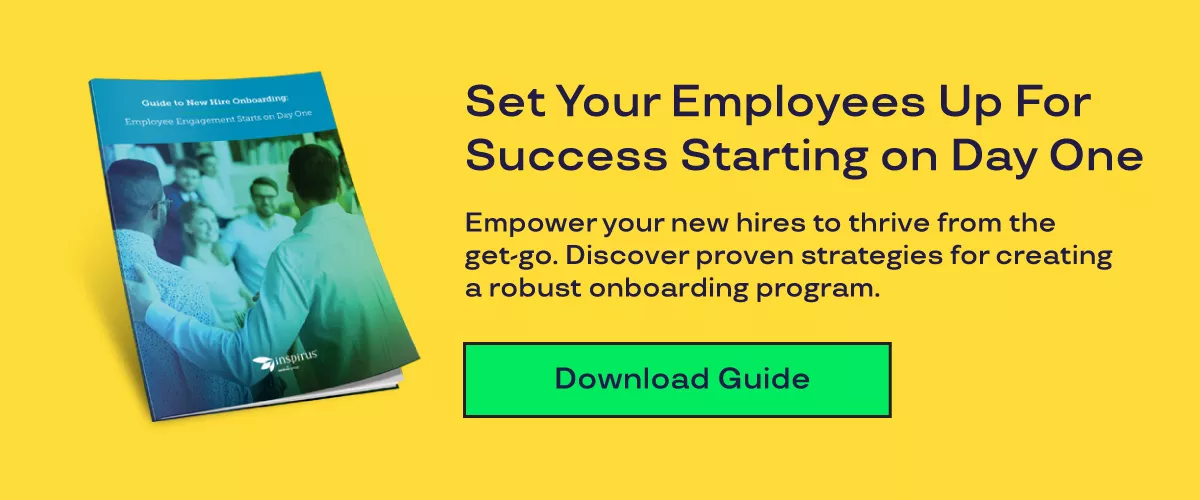
Best Practices for a Successful Employee Onboarding
March 6, 2024
There is no question about how important onboarding is for an employee’s journey and, ultimately, a company’s bottom line.
A well-structured process that follows best practices in employee onboarding is essential for fostering engagement and retention. On the flip side, a negative or non-existent onboarding experience can send a new employee running.
More than one-third of employees leave an organization within one year. Compare that to the 69 percent of employees who are more likely to stay with a company for three years if they receive a great onboarding experience. With persistent skilled labor shortages and “quiet quitting” making headlines, retention of an engaged workforce is critical.
And that’s just one piece of the puzzle. Employees who had effective onboarding say they feel up to 18 times more committed to their workplace while employers say they see up to a 50 percent increase in productivity after following a set employee onboarding program.
Making new hires feel welcomed, valued and prepared to contribute effectively isn’t easy, but it's well worth the investment. Here are some proven strategies for effective employee onboarding that will have a measurable impact.
The Onboarding Process
Employee onboarding, at its essence, is focused on integrating new employees into an organization's culture and helping them succeed in their role for years to come.
As with anything, the first step to success is to set actionable and measurable goals. During the onboarding process, that means making sure new hires:
- Are acclimated and aligned with the company's mission, vision and culture.
- Understand their job responsibilities and bigger picture within the company.
- Are equipped with the necessary tools and resources to succeed.
- Will be able to continue developing skills and knowledge to keep improving.
- Feel supported and valued by the company, with opportunities to provide feedback.
The onboarding process can be broken down into three main phases. This is important to note because each stage comes with its own set of challenges and best practices.
- Pre-boarding: This stage is before the new employee’s first day on the job and can involve activities like completing HR paperwork, setting up workstations, securing access and introducing new hires to their team members.
- Orientation: This is the formal introduction to the company and its culture, where new employees learn about the company's mission, values and policies. This is the stage that many typically associate with onboarding – the employee’s first few days on the job – but orientation is distinct from onboarding.
- Integration: Onboarding doesn’t end after a set number of days. Integration is a continuous learning process to help employees get comfortable with their teams and more fully contribute to company goals.
The most important takeaway is the fact that onboarding is so much more than just paperwork and shouldn’t be treated as one more to-do on a checklist of formalities. A strong, thoughtful onboarding process is essential for any organization’s long-term success.
Best Practices for Pre-boarding
Pre-boarding, that period between when a candidate accepts an offer and their first day on the job, lays the foundation for the rest of an effective onboarding experience. That’s why it’s essential to get this part right – it sets the tone for all their interactions with the company.
Here are some areas to prioritize during pre-boarding:
- Clear Communication: Maintain regular, clear and transparent communication with the new hire. Send a welcome email, providing them with an employee handbook or other relevant documents, and answer any questions they may have.
- Set Expectations: Clearly outline what the new hire can expect on their first day, including what time they should arrive (or login, if remote), who they will be meeting with and what they should bring with them.
- Prepare the Work Environment: Ensure that the new hire's workspace is ready for their arrival. This includes setting up their computer any other necessary equipment, as well as making sure they have access to any software or services they will be using.
- Welcome the New Hire: Make the new hire feel welcome and valued even before their first day on the job. A welcoming note from their team or manager – in addition to the more formal email from HR – can go a long way in building a sense of community. Consider setting up a welcome lunch or coffee with their team (or a remote one with a coffee on-the-house) for the first day or providing them with a welcome kit with company swag.
Pre-boarding is an opportunity to welcome the new hire to the team and make them feel valued and appreciated – something that continues during and beyond their first day!
Crafting a Comprehensive Orientation Plan
Orientation is different from the longer-term process of onboarding (more on that below!), but there are some important activities that need to be completed in this stage of the employee journey.
While pre-boarding occurs before the employee starts and onboarding is the long-term process, orientation fits in between: it’s typically the first few days or weeks to situate a new employee and ensure they get off on the right foot.
To maximize the opportunities during this stage, tailor the orientation to the employee’s skill sets, interests and role. A more personalized plan, versus a one-size-fits-all approach, acknowledges these differences and ensures that each employee is supported in the best possible way.
During orientation, it’s also beneficial to assign a mentor where new employees are paired with an experienced peer who can help provide guidance and support. Not only does this help the new hire navigate the organization and facilitate knowledge sharing, but it’s also an important way to foster long-term connection in the workplace.
Building Company Culture and Integration Through Onboarding
Bringing someone new into the fold and getting them integrated with a company’s culture and mission isn’t a one-time event. It’s an ongoing process that lasts the duration of their tenure at the company. When paired with a thoughtful pre-boarding and orientation process, this holistic approach to ongoing onboarding is incredibly powerful.
Training and Skill Development
Of course, you should provide training relevant to the employee's role – this is essential to their success and productivity. In addition to technical training, though, soft skills development and industry-specific knowledge is valuable for career development and progression. The better an employee is equipped to contribute to the company’s goals, the better they will do.
Additionally, investing in employees' development beyond Day One contributes to creating a culture of continuous learning and improvement. That, in turn, also leads to higher employee engagement and retention.
Providing Support and Resources
Mentorship is a powerful tool during the orientation phase as the new employee adjusts to the company and their role during the first few weeks, as mentioned above. These connections continue to be valuable throughout the entire onboarding journey and one of the best ways to foster a supporting work environment.
In addition to mentorship, it's important to provide new employees with the necessary resources and support channels. How do you know what an employee needs? Through feedback.
Regular feedback sessions can be built into the onboarding process to ensure that employees receive what they need – whether that’s IT support, online resources, training, guidance or any other type of resource. Using innovative tools like Inspirus' employee engagement platform in partnership with The Happiness Index (THI), for instance, allows organizations to gain valuable feedback on the effectiveness of the onboarding process, ensuring new employees feel supported and engaged from the start.
Frequently Asked Questions
What is the most important employee onboarding activity?
There are several critical elements to employee onboarding and no one activity will be sufficient by itself. That’s why it’s so important to have a comprehensive onboarding plan that encompasses all stages of onboarding. In broad strokes, though, employee onboarding activities should be personalized, clearly communicated, paired with a peer mentorship element and include opportunities for feedback.
What is an onboarding framework?
An onboarding framework provides a roadmap for HR and managers to follow, outlining the key stages, activities and resources needed to successfully integrate new hires into the organization. This ensures all new employees receive a consistent, positive and effective onboarding experience.
How to design onboarding to improve employee engagement?
Onboarding sets the stage for improving employee engagement by creating a positive and welcoming environment for new hires, setting clear objectives and providing ongoing support. It also fosters connections with colleagues and teams, encourages open communication and provides opportunities for growth.





